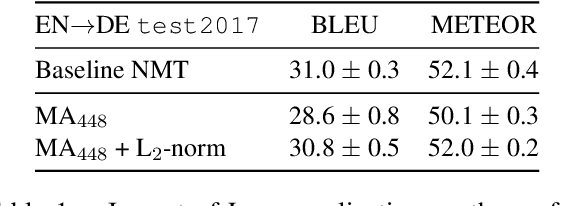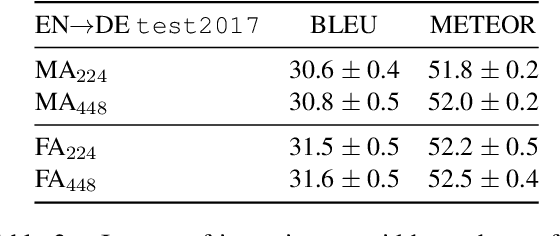Walid Aransa
LIUM Machine Translation Systems for WMT17 News Translation Task
Jul 14, 2017



Abstract:This paper describes LIUM submissions to WMT17 News Translation Task for English-German, English-Turkish, English-Czech and English-Latvian language pairs. We train BPE-based attentive Neural Machine Translation systems with and without factored outputs using the open source nmtpy framework. Competitive scores were obtained by ensembling various systems and exploiting the availability of target monolingual corpora for back-translation. The impact of back-translation quantity and quality is also analyzed for English-Turkish where our post-deadline submission surpassed the best entry by +1.6 BLEU.
LIUM-CVC Submissions for WMT17 Multimodal Translation Task
Jul 14, 2017



Abstract:This paper describes the monomodal and multimodal Neural Machine Translation systems developed by LIUM and CVC for WMT17 Shared Task on Multimodal Translation. We mainly explored two multimodal architectures where either global visual features or convolutional feature maps are integrated in order to benefit from visual context. Our final systems ranked first for both En-De and En-Fr language pairs according to the automatic evaluation metrics METEOR and BLEU.
NMTPY: A Flexible Toolkit for Advanced Neural Machine Translation Systems
Jun 01, 2017



Abstract:In this paper, we present nmtpy, a flexible Python toolkit based on Theano for training Neural Machine Translation and other neural sequence-to-sequence architectures. nmtpy decouples the specification of a network from the training and inference utilities to simplify the addition of a new architecture and reduce the amount of boilerplate code to be written. nmtpy has been used for LIUM's top-ranked submissions to WMT Multimodal Machine Translation and News Translation tasks in 2016 and 2017.
Does Multimodality Help Human and Machine for Translation and Image Captioning?
Aug 16, 2016



Abstract:This paper presents the systems developed by LIUM and CVC for the WMT16 Multimodal Machine Translation challenge. We explored various comparative methods, namely phrase-based systems and attentional recurrent neural networks models trained using monomodal or multimodal data. We also performed a human evaluation in order to estimate the usefulness of multimodal data for human machine translation and image description generation. Our systems obtained the best results for both tasks according to the automatic evaluation metrics BLEU and METEOR.
 Add to Chrome
Add to Chrome Add to Firefox
Add to Firefox Add to Edge
Add to Edge